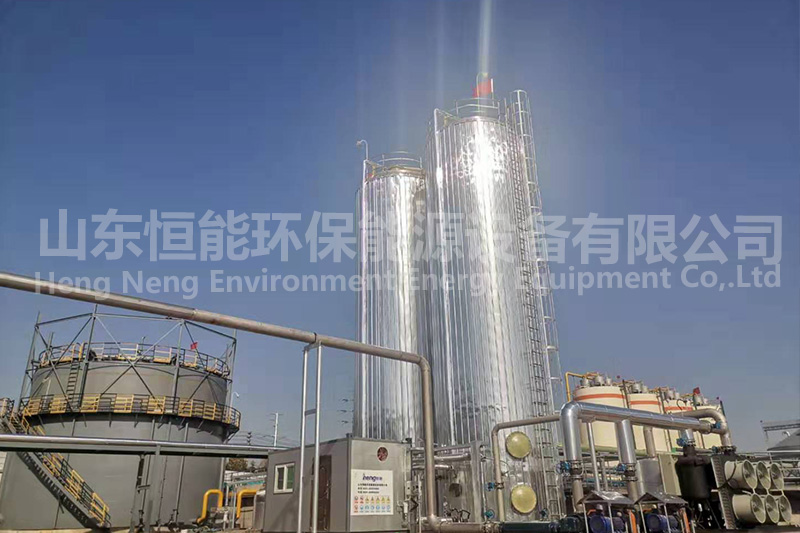沼气,顾名思义,就是沼气,是有机物在厌氧条件下的混合物,通过微生物发酵而形成的一种混合物气体。我们经常看到,在沼泽里,在下水道里,或在粪池里,都有气泡冒出来,如果我们划一根火柴,就能把它点燃。这是天然生成的甲烷。由于这种气体初是在沼泽中发现的,所以被称为甲烷。人畜粪便、秸秆、污水等有机物在密闭的沼气池中,在厌氧(无氧)条件下发酵,从而产生沼气。沼气是一种可以燃烧的混合气体。沼气是微生物对有机物进行厌氧消化产生的可燃气体。沼气是多种气体的混合物,通常含有50%到70%的甲烷,其余是二氧化碳和少量的氮气、氢气和硫化氢。它的性质与天然气相似。
Biogas, as the name implies, is a mixture of organic substances under anaerobic conditions, which is formed by microbial fermentation. We often see bubbles coming out in swamps, sewers or cesspools. If we strike a match, we can light it. It's natural methane. Since this gas was first found in swamps, it is called methane. Biogas is produced by anaerobic (anaerobic) fermentation of human and animal manure, straw, sewage and other organic matters in a closed biogas digester. Biogas is a combustible mixture. Biogas is a combustible gas produced by anaerobic digestion of organic matter by microorganisms. Biogas is a mixture of many gases, usually containing 50% to 70% methane, the rest is carbon dioxide and a small amount of nitrogen, hydrogen and hydrogen sulfide. Its nature is similar to that of natural gas.
沼气是有机物在隔离空气和保持一定湿度、温度、ph等条件下,经过多种微生物(统称沼气细菌)分解而产生的。细菌分解有机物产生沼气的过程叫做沼气发酵。这是产甲烷的基本原理,即厌氧机理,人工产甲烷必须具备两个条件:,必须有严格的厌氧环境;二是发酵原料充足,菌剂充足,发酵浓度、发酵温度、ph值适宜。发酵的生化过程可分为三个阶段:
Biogas is produced by the decomposition of a variety of microorganisms (collectively referred to as biogas bacteria) under the conditions of air isolation and maintaining a certain humidity, temperature, pH, etc. The process of biogas production by bacteria is called biogas fermentation. This is the basic principle of methanogenesis, i.e. anaerobic mechanism. Artificial methanogenesis must have two conditions: first, there must be a strict anaerobic environment; second, there must be sufficient fermentation raw materials, sufficient bacterial agents, and appropriate fermentation concentration, fermentation temperature and pH value. The biochemical process of fermentation can be divided into three stages:
阶段1(液化阶段):可发酵细菌使用由细菌分泌的胞外酶分解等大型分子有机物家禽粪便、作物秸秆和废水处理的大豆产品成小分子化合物如单糖、氨基酸、甘油和脂肪酸,溶于水。
Stage 1 (liquefying stage): fermentable bacteria use large molecular organics such as extracellular enzymes secreted by bacteria to decompose poultry manure, crop straw and soybean products for wastewater treatment to form small molecular compounds such as monosaccharide, amino acid, glycerin and fatty acid, which are soluble in water.

第二阶段(制酸阶段):发酵菌将小分子化合物分解成乙酸、丙酸、丁酸、氢和二氧化碳等,再转化成乙酸、氢和二氧化碳,供产甲烷菌利用。
The second stage (acid making stage): fermentation bacteria decompose small molecular compounds into acetic acid, propionic acid, butyric acid, hydrogen and carbon dioxide, and then convert them into acetic acid, hydrogen and carbon dioxide for methanogens to use.
第三阶段(产甲烷阶段):产甲烷菌菌落,利用上述三种产甲烷菌分解转化甲酸、乙酸、氢和二氧化碳小分子化合物产生甲烷。沼气发酵的三个阶段相互依存、连续不断,保持着动态平衡。在沼气发酵的初始阶段,和第二阶段起主要作用,同时也是第三阶段的作用。在沼气发酵的后期,三个阶段的作用是同时进行的,经过一定的时间,保持一定的动态平衡,继续正常的产气。
The third stage (methanogenic stage): methanogenic bacteria colony, using the above three methanogenic bacteria to decompose and transform formic acid, acetic acid, hydrogen and carbon dioxide small molecular compounds to produce methane. The three stages of biogas fermentation are interdependent and continuous, maintaining a dynamic balance. In the initial stage of biogas fermentation, the first and second stages play the main role, but also the third stage. In the later stage of biogas fermentation, the three stages are carried out at the same time. After a certain period of time, maintain a certain dynamic balance and continue to produce gas normally.
